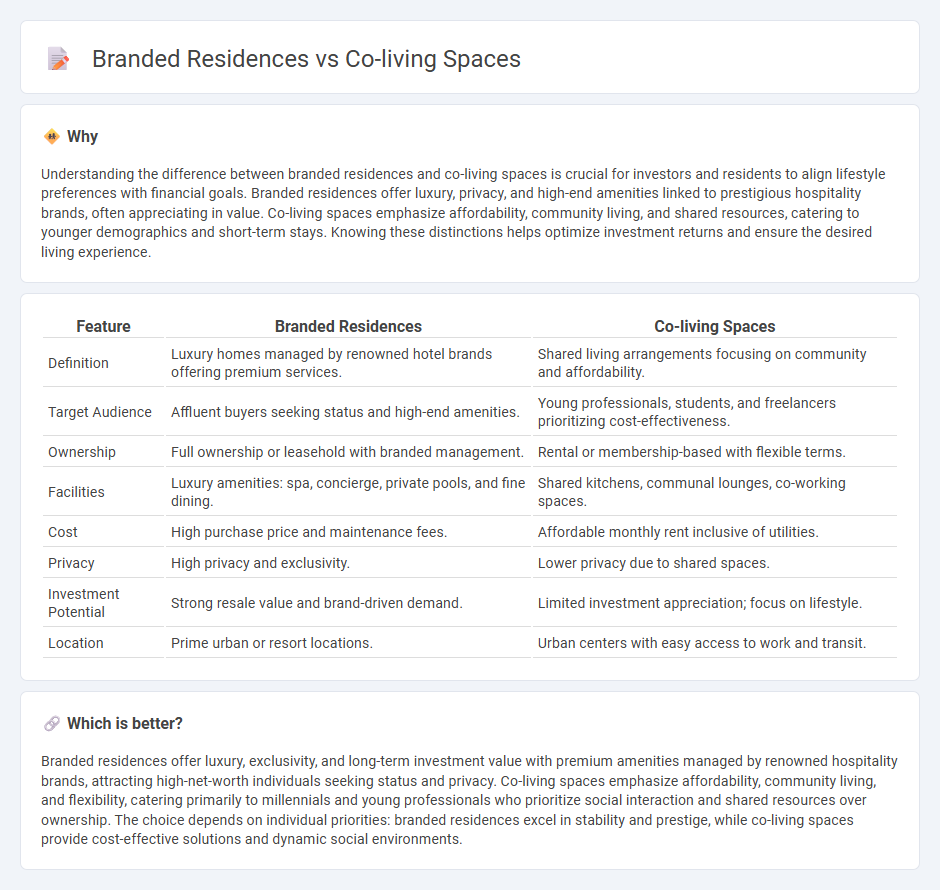
Branded residences offer luxury living experiences with premium amenities and global brand recognition, catering to high-net-worth individuals seeking exclusivity and investment value. Co-living spaces provide affordable, flexible housing solutions that promote community engagement and shared resources, appealing to millennials and urban professionals. Explore the key differences and benefits of branded residences versus co-living spaces to find the ideal real estate choice for your lifestyle.
Why it is important
Understanding the difference between branded residences and co-living spaces is crucial for investors and residents to align lifestyle preferences with financial goals. Branded residences offer luxury, privacy, and high-end amenities linked to prestigious hospitality brands, often appreciating in value. Co-living spaces emphasize affordability, community living, and shared resources, catering to younger demographics and short-term stays. Knowing these distinctions helps optimize investment returns and ensure the desired living experience.
Comparison Table
| Feature | Branded Residences | Co-living Spaces |
|---|---|---|
| Definition | Luxury homes managed by renowned hotel brands offering premium services. | Shared living arrangements focusing on community and affordability. |
| Target Audience | Affluent buyers seeking status and high-end amenities. | Young professionals, students, and freelancers prioritizing cost-effectiveness. |
| Ownership | Full ownership or leasehold with branded management. | Rental or membership-based with flexible terms. |
| Facilities | Luxury amenities: spa, concierge, private pools, and fine dining. | Shared kitchens, communal lounges, co-working spaces. |
| Cost | High purchase price and maintenance fees. | Affordable monthly rent inclusive of utilities. |
| Privacy | High privacy and exclusivity. | Lower privacy due to shared spaces. |
| Investment Potential | Strong resale value and brand-driven demand. | Limited investment appreciation; focus on lifestyle. |
| Location | Prime urban or resort locations. | Urban centers with easy access to work and transit. |
Which is better?
Branded residences offer luxury, exclusivity, and long-term investment value with premium amenities managed by renowned hospitality brands, attracting high-net-worth individuals seeking status and privacy. Co-living spaces emphasize affordability, community living, and flexibility, catering primarily to millennials and young professionals who prioritize social interaction and shared resources over ownership. The choice depends on individual priorities: branded residences excel in stability and prestige, while co-living spaces provide cost-effective solutions and dynamic social environments.
Connection
Branded residences and co-living spaces both target urban professionals seeking lifestyle-oriented real estate with premium amenities and community-focused environments. These models emphasize curated experiences, combining luxury living with social interaction in high-demand metropolitan areas. By leveraging brand reputation and shared spaces, they attract tenants looking for convenience, status, and networking opportunities in competitive housing markets.
Key Terms
Communal Living
Co-living spaces offer flexible, affordable communal living with shared amenities that foster social interaction among diverse residents, while branded residences provide luxury private living backed by renowned hospitality brands emphasizing exclusivity and premium services. Co-living prioritizes community engagement and affordability, appealing to young professionals and digital nomads, whereas branded residences target affluent buyers seeking status and bespoke experiences. Explore the key differences and benefits of communal living options to determine which lifestyle suits your needs best.
Hospitality Services
Co-living spaces emphasize flexible, community-driven hospitality services tailored for social interaction and convenience, often including shared amenities such as kitchens, lounges, and coworking areas. Branded residences offer luxury hospitality standards with personalized services like concierge, housekeeping, and exclusive access to hotel-like facilities, aligning with premium lifestyle expectations. Explore the distinct hospitality experiences and service models defining co-living and branded residences to find the best fit for your living preferences.
Property Management
Co-living spaces prioritize community-driven property management with flexible lease terms and shared amenities designed to foster social interaction among residents. Branded residences emphasize premium property management services that maintain high standards, personalized concierge, and exclusive access to luxury facilities under a recognized brand name. Explore the distinct management models to determine which aligns best with your lifestyle and investment goals.
Source and External Links
Co-living - A residential community living model where three or more biologically unrelated people share the same dwelling, increasingly popular due to affordable housing crises and sustainability benefits from shared resources.
Co-Living in LA and Seattle: Pros, Cons, and Tips - Co-living spaces provide affordable, community-oriented housing with flexible leases, inclusive utilities, and appeal especially to young professionals, students, and digital nomads in expensive urban centers.
5 co-living spaces that raise the game in the US - Examples of innovative US co-living spaces like The Forge in Portland offering coworking with living, and Euclid Manor in Oakland emphasizing creative community and social impact through resident-led projects.
 dowidth.com
dowidth.com